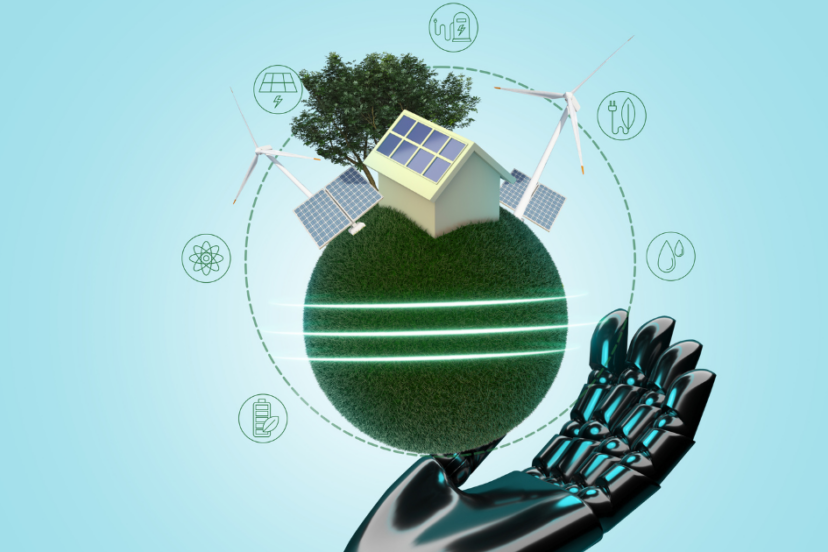How Can Artificial Intelligence and Environment Conservation Saves the Earth
Do you ever wonder how technology is helping us save the planet? Well, prepare for an exciting journey into the world of Responsible AI – where machines and nature join forces to protect our Earth. We’re about to embark on a journey on how can Artificial Intelligence and Environment conservation help save the earth.
This blog will take you on a simple, engaging tour of how AI revolutionizes environmental conservation. We’ll show you how it helps us save endangered species, predict climate changes, and more. So, let’s dive in and discover how AI is making our world a better place, one smart move at a time.
Artificial Intelligence and Environment Transformation
Artificial Intelligence (AI) has emerged as a powerful tool in addressing and mitigating environmental challenges. Here are several ways in which AI plays a crucial role in limiting environmental dangers:
Energy Efficiency:
- Smart Buildings: AI can optimize heating, cooling, and lighting systems in buildings, reducing energy consumption while maintaining comfort.
- Predictive Maintenance: AI can analyze sensor data from industrial equipment to predict and prevent breakdowns, reducing downtime and energy waste.
- Grid Management: AI helps balance energy supply and demand in smart grids, integrating renewable energy sources efficiently.
Renewable Energy:
- Solar and Wind Power: AI can forecast weather patterns and energy demand to optimize the operation of solar and wind farms, increasing energy production.
- Energy Storage: AI can enhance the efficiency of energy storage systems like batteries by optimizing charging and discharging cycles.
Conservation and Biodiversity:
- Monitoring Endangered Species: AI-driven camera traps and acoustic sensors can identify and track endangered species, aiding conservation efforts.
- Habitat Preservation: AI helps identify areas of high ecological importance, guiding land-use decisions to protect critical habitats.
Waste Management:
- Recycling Sorting: AI-powered robots can sort recyclables from waste materials in recycling plants, increasing recycling rates and reducing landfill waste.
- Waste Reduction: Predictive analytics can optimize waste collection routes, minimizing fuel consumption and emissions.
Water Management:
- Water Quality Monitoring: AI can analyze sensor water quality data to detect pollution and ensure safe drinking water.
- Irrigation: AI-driven precision irrigation systems optimize water use in agriculture, reducing water wastage.
Natural Disaster Response:
- Early Warning Systems: AI can analyze data from sensors, satellites, and social media to provide early warnings for natural disasters, allowing for timely evacuations and preparation.
- Disaster Recovery: AI-driven drones and robots can assess damage, locate survivors, and aid in disaster recovery efforts.
Transportation:
- Electric Vehicles: AI improves the efficiency of electric vehicle batteries and charging infrastructure, making electric vehicles more accessible and environmentally friendly.
- Public Transportation: AI-driven systems can optimize public transit routes, reducing congestion and emissions.
Agriculture:
- Precision Farming: AI can analyze soil and weather data to optimize planting and harvesting, reducing the use of fertilizers and pesticides.
- Crop Monitoring: AI-equipped drones can monitor crop health and identify disease outbreaks early, enabling targeted interventions.
Negative Impact of AI on the Environment
While AI offers numerous advantages in addressing environmental challenges, it also presents several disadvantages:
- Energy Consumption: AI systems, particularly deep learning models, demand significant computational power and energy resources. Training and running AI models on a large scale can contribute to increased energy consumption, which may indirectly lead to environmental harm, especially if the energy comes from non-renewable sources.
- Electronic Waste: The rapid development of AI technologies leads to frequent hardware upgrades and replacements, contributing to the accumulation of electronic waste (e-waste). E-waste disposal can be environmentally damaging if not managed properly, as it often contains toxic materials.
- Overreliance on Technology: As AI becomes more integrated into environmental monitoring and management, there is a risk of overreliance on technology, potentially diminishing human engagement with and understanding of ecosystems. This disconnect from nature could lead to unforeseen consequences or reduced empathy for environmental issues.
How Can Humans Help The AI in Transforming the Environment for a Better Tomorrow
Data Collection and Labeling:
Humans can contribute to environmental AI projects by collecting and labeling data. This includes gathering information on wildlife sightings, pollution levels, weather patterns, etc. High-quality labeled data is essential for training AI models effectively.
Citizen Science Initiatives:
Participate in citizen science programs and initiatives. Many organizations and researchers collaborate with the public to collect data on environmental changes and wildlife observations. By getting involved, individuals can provide valuable data for AI analysis.
Feedback and Improvement:
Continuously provide feedback to AI developers and researchers. Report any inaccuracies or issues encountered while using AI-powered environmental apps or tools. This feedback helps improve AI models and algorithms.
Environmental Advocacy:
Advocate for AI investments in environmental research and applications. Support policies and initiatives that allocate resources to AI projects focused on climate change mitigation, conservation, and sustainability.
Education and Training:
Learn about AI and its applications in environmental science. Many online courses and resources are available to help individuals understand AI technology better. Knowledge about AI can empower people to make informed decisions and contribute to AI-driven environmental efforts.
Ethical Considerations:
Stay informed about ethical considerations related to AI in the environment. Advocate for responsible AI development, emphasizing fairness, transparency, and privacy protections in environmental AI applications.
Collaboration:
Collaborate with AI experts and environmental organizations. Multidisciplinary collaborations can lead to innovative solutions and the development of AI tools that address specific ecological challenges effectively.
Support Research and Development:
Support organizations and initiatives that conduct AI research for environmental purposes. Donations or investments in AI projects can accelerate ecological conservation and sustainability progress.
Spread Awareness:
Raise awareness about the potential of AI in environmental transformation among your network and community. Encourage others to get involved in AI-driven ecological projects and initiatives.
Conclusion
In summary, Artificial Intelligence (AI) is changing our environment in amazing ways. It helps us protect animals, grow food better, fight climate change, and manage waste smarter.
AI is like a super-smart assistant that uses data to make good decisions. With AI, we’re ensuring animals are safe, growing food more efficiently, understanding climate better, and reducing waste.
As we use AI more, we’re making our world cleaner and greener. We’re working together with AI to create a better future for our planet. AI is a powerful tool for taking care of our home.




